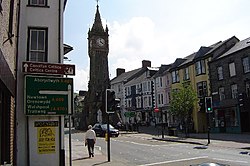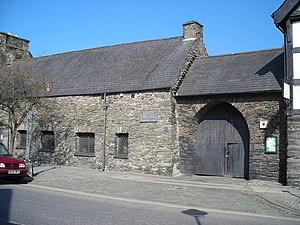Machynlleth: Difference between revisions
Created page with '{{Infobox town |name=Machynlleth |county=Montgomeryshire |picture=MachynllethTownClock.jpg |picture caption=The Clock Tower, Machynlleth | latitude= 52.59087 | longitude= -3.8488…' |
m clean up, typos fixed: medium sized → medium-sized |
||
| (One intermediate revision by one other user not shown) | |||
| Line 15: | Line 15: | ||
| os grid ref=SH745005 | | os grid ref=SH745005 | ||
}} | }} | ||
'''Machynlleth''', sometimes referred to colloquially as ''Mach'', is a market town in [[Montgomeryshire]]. It is in the [[River | '''Machynlleth''', sometimes referred to colloquially as ''Mach'', is a market town in [[Montgomeryshire]]. It is in the [[River Dovey|Dovey Valley]]. | ||
The town was the seat of the rebel Owain Glyndŵr's Welsh Parliament in 1404,<ref>''The Welsh Academy Encyclopaedia of Wales''. John Davies, Nigel Jenkins, Menna Baines and Peredur Lynch (2008) pg527 ISBN 9780708319536</ref> and as such claims to be the "ancient capital of Wales". On that basis applied for city status in 2000 and 2002 but was unsuccessful. | The town was the seat of the rebel Owain Glyndŵr's Welsh Parliament in 1404,<ref>''The Welsh Academy Encyclopaedia of Wales''. John Davies, Nigel Jenkins, Menna Baines and Peredur Lynch (2008) pg527 ISBN 9780708319536</ref> and as such claims to be the "ancient capital of Wales". On that basis applied for city status in 2000 and 2002 but was unsuccessful. | ||
| Line 36: | Line 36: | ||
The weekly market and biannual fair thrived, and in 1613 drew complaints from other towns whose trading in cloth was being severely affected. A document dated 1632 shows that animals for sale came from all over [[Merionethshire]], [[Montgomeryshire]], [[Cardiganshire]], [[Carmarthenshire]] and [[Denbighshire]], and prospective buyers came from [[Flintshire]], [[Radnorshire]], [[Brecknockshire]], [[Herefordshire]] and [[Shropshire]], in addition to the above. | The weekly market and biannual fair thrived, and in 1613 drew complaints from other towns whose trading in cloth was being severely affected. A document dated 1632 shows that animals for sale came from all over [[Merionethshire]], [[Montgomeryshire]], [[Cardiganshire]], [[Carmarthenshire]] and [[Denbighshire]], and prospective buyers came from [[Flintshire]], [[Radnorshire]], [[Brecknockshire]], [[Herefordshire]] and [[Shropshire]], in addition to the above. | ||
On 29 November 1644, a Civil War battle took place near | On 29 November 1644, a Civil War battle took place near Dovey Bridge between Oliver Cromwell's New Model Army, under the command of Sir Thomas Myddelton of Chirk Castle, and the Royalists. A great many were killed and the nearby manor house Mathafarn was burnt down on the same day. Many houses in Machynlleth occupied by Royalists were also burned down. | ||
The | The Dovey Bridge was first mentioned in 1533, by Geoffrey Hughes, "Citizen and Merchant taylour of London" who left £6 13s 4d "towards making of a bridge at the toune of Mathanlleth". By 1601 "Dyfi bridge in the Hundred of Mochunleth" was reported to be insufficient, and the current one was built in 1805 for £250. Fenton describes it in 1809 as "A noble erection of five large arches. The piers are narrow and over each cut-water is a pilaster, a common feature of the eighteenth century". | ||
==Plas Machynlleth and the Londonderry Family== | ==Plas Machynlleth and the Londonderry Family== | ||
| Line 57: | Line 57: | ||
==Tourism== | ==Tourism== | ||
The primary employment sector remains tourism with a wide range of activity based attractions (for example several mountain biking trails) as well as visitor centres (Centre for Alternative Technology). Agriculture continues to play a significant part in the make-up of the town and surrounding area. Another important local industry and employer is the renewable energy sector. Driven by the local Centre for Alternative Technology, the area pays host to a large windfarm and research centre dedicated to the development of renewable energy resources. The area now has a rapidly-expanding renewable energy industry with several small to medium sized companies now operating in or around the town. | The primary employment sector remains tourism with a wide range of activity based attractions (for example several mountain biking trails) as well as visitor centres (Centre for Alternative Technology). Agriculture continues to play a significant part in the make-up of the town and surrounding area. Another important local industry and employer is the renewable energy sector. Driven by the local Centre for Alternative Technology, the area pays host to a large windfarm and research centre dedicated to the development of renewable energy resources. The area now has a rapidly-expanding renewable energy industry with several small to medium-sized companies now operating in or around the town. | ||
The town has a large market on Wednesdays which includes traditional Welsh stalls plus Spanish and French food stalls. The Wales Museum of Modern Art presents talks and performances on market days. | The town has a large market on Wednesdays which includes traditional Welsh stalls plus Spanish and French food stalls. The Wales Museum of Modern Art presents talks and performances on market days. | ||
Latest revision as of 17:42, 28 January 2016
| Machynlleth | |
| Montgomeryshire | |
|---|---|
 The Clock Tower, Machynlleth | |
| Location | |
| Grid reference: | SH745005 |
| Location: | 52°35’27"N, 3°50’56"W |
| Data | |
| Population: | 2,147 (2001) |
| Post town: | Machynlleth |
| Postcode: | SY20 |
| Dialling code: | 01654 |
| Local Government | |
| Council: | Powys |
| Parliamentary constituency: |
Montgomeryshire |
Machynlleth, sometimes referred to colloquially as Mach, is a market town in Montgomeryshire. It is in the Dovey Valley.
The town was the seat of the rebel Owain Glyndŵr's Welsh Parliament in 1404,[1] and as such claims to be the "ancient capital of Wales". On that basis applied for city status in 2000 and 2002 but was unsuccessful.
The Centre for Alternative Technology lies outside the town.
History
A small Roman fort stood at Pennal (Cefn Caer) four miles west of Machynlleth, and is reputed to have had two look-out posts above the town at Bryn-y-gog and Wylfa. One of the earliest written references to Machynlleth is the royal charter granted in 1291 by King Edward I to Owen de la Pole, Lord of Powys, which gave him the right to hold a market[2] at Machynlleth every Wednesday for ever and two fairs every year. The Wednesday market is still a busy and popular day in Machynlleth 700 years on.
Royal House, which stands on the corner of the Garsiwn, is another of the mediæval houses that can still be seen today. According to local tradition, Dafydd Gam, a Welsh ally of the English Kings, was imprisoned here from 1404 to 1412 for attempting to assassinate Owain Glyndŵr. After his release by Glyndŵr, Gam fought alongside King Henry V at the Battle of Agincourt and is named amongst the dead in Shakespeare's Henry V. The name "Royal House" is later, undoubtedly referring to the tradition that King Charles I stayed at the house in 1643.
Owain Glyndŵr

Machynlleth has a special role in Welsh history because of its connection with Owain Glyndŵr, who rebelled against the English during the reign of King Henry IV. Owain was crowned "Prince of Wales" in 1404 near the Parliament House, which is one of three mediæval houses in town, in the presence of leaders from Scotland, France and Spain, and he held his own Parliament in the town. He held his last parliament in the nearby village of Pennal, by the Church of St Peter ad Vincula.
It is thought that after the rebellion floundered, Owain went into hiding in the area around Machynlleth.
Machynlleth in the Modern Period
The weekly market and biannual fair thrived, and in 1613 drew complaints from other towns whose trading in cloth was being severely affected. A document dated 1632 shows that animals for sale came from all over Merionethshire, Montgomeryshire, Cardiganshire, Carmarthenshire and Denbighshire, and prospective buyers came from Flintshire, Radnorshire, Brecknockshire, Herefordshire and Shropshire, in addition to the above.
On 29 November 1644, a Civil War battle took place near Dovey Bridge between Oliver Cromwell's New Model Army, under the command of Sir Thomas Myddelton of Chirk Castle, and the Royalists. A great many were killed and the nearby manor house Mathafarn was burnt down on the same day. Many houses in Machynlleth occupied by Royalists were also burned down.
The Dovey Bridge was first mentioned in 1533, by Geoffrey Hughes, "Citizen and Merchant taylour of London" who left £6 13s 4d "towards making of a bridge at the toune of Mathanlleth". By 1601 "Dyfi bridge in the Hundred of Mochunleth" was reported to be insufficient, and the current one was built in 1805 for £250. Fenton describes it in 1809 as "A noble erection of five large arches. The piers are narrow and over each cut-water is a pilaster, a common feature of the eighteenth century".
Plas Machynlleth and the Londonderry Family
In 1846 Mary Cornelia, the daughter of local landowner Sir John Edwards, married George Vane-Tempest, Viscount Seaham, the second son of the third Marquess of Londonderry and they set up home in Plas Machynlleth. George became Earl Vane on the death of his father and the fifth Marquess of Londonderry on the death of his half-brother.
To celebrate the 21st birthday of their eldest son, Viscount Castlereagh, the townspeople subscribed to the erection (at the town's main road intersection) of the Clock Tower, which has become widely known as the symbol of Machynlleth. The tower, which stands on the site of the old Town Hall, is the first thing many visitors will notice. The foundation stone was laid on 15 July 1874 amid great festivities.
Another son, Lord Herbert Vane-Tempest, was the last member of the family to live at the Plas and was killed in the Abermule train collision on the Cambrian Railways, of which he was a director.
The house was given to the townspeople in December 1948 under the stewardship of the then Urban District Council. In 1996 the local council converted Plas House into the “Celtica” visitor centre. Celtica closed in March 2006 and stood empty until Machynlleth Town Council took ownership of the Plas and its parkland and facilities. It is let out to a restaurant and for offices and conference space.
Culture
Machynlleth retains its strong Welsh character; Welsh is spoken alongside English. The 2001 census indicated that 70% of the 2000-strong population have some knowledge of Welsh with 42% able to read, write and speak the language.[3]
Machynlleth hosted the National Eisteddfod in 1937 and 1981.
Tourism
The primary employment sector remains tourism with a wide range of activity based attractions (for example several mountain biking trails) as well as visitor centres (Centre for Alternative Technology). Agriculture continues to play a significant part in the make-up of the town and surrounding area. Another important local industry and employer is the renewable energy sector. Driven by the local Centre for Alternative Technology, the area pays host to a large windfarm and research centre dedicated to the development of renewable energy resources. The area now has a rapidly-expanding renewable energy industry with several small to medium-sized companies now operating in or around the town.
The town has a large market on Wednesdays which includes traditional Welsh stalls plus Spanish and French food stalls. The Wales Museum of Modern Art presents talks and performances on market days.
References
- ↑ The Welsh Academy Encyclopaedia of Wales. John Davies, Nigel Jenkins, Menna Baines and Peredur Lynch (2008) pg527 ISBN 9780708319536
- ↑ The Welsh Academy Encyclopaedia of Wales. John Davies, Nigel Jenkins, Menna Baines and Peredur Lynch (2008) pg527 ISBN 9780708319536
- ↑ 2001 Census Neighbourhood Statistics: Machynlleth